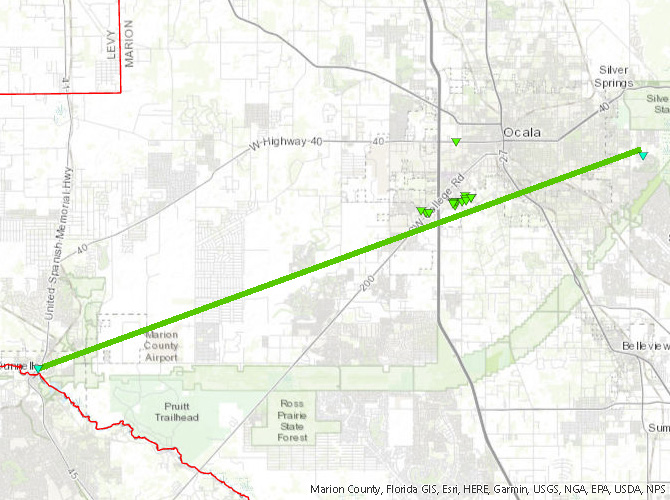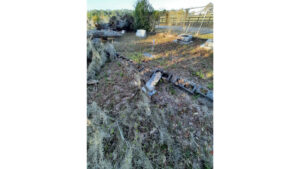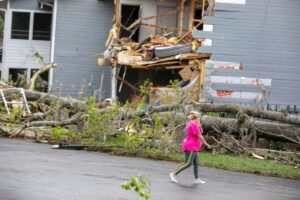The “under the radar” tornado of March 12

The path of the March 12 tornado according to the NWS.
Strong early morning storms and one confirmed tornado caused severe damage to some areas of Marion County on Saturday morning, March 12. Although a tornado watch was issued at 3:30 a.m. by the National Weather Service (NWS), many residents are asking why there were no warnings issued as the storm touched down in the area.
According to the latest updated report by the NWS, the tornado started at 7:45 a.m. and traveled 26.67 miles from downtown Dunnellon, through SW Ocala before ending just past Baseline Road near SE 8th Street Road at 8:20 a.m.
Julie Danoski, records custodian for the city of Dunnellon, said city staff estimates the tornado started around the old Rockwell cemetery, uprooting old trees and gravestones before damaging a large billboard nearby.

The March 12 tornado may have started from around Rockwell Cemetery in downtown Dunnellon before traveling into Ocala. [Photo supplied City of Dunnellon]
Many Marion County residents have since wondered why they did not receive an AlertMarion text warning of the impending tornado.
Paul Bloom, spokesperson for the Marion County Sheriff’s Office, explained there were a few factors at play. First, the radar at the Jacksonville NWS office was “off-line as part of a scheduled maintenance,” he said, leaving Marion County with “radar coverage from their station in the Tampa area and one in Valdosta, GA.”
Pete Wolf, Science & Operations Officer for the Jacksonville NWS office, said the station’s Doppler radar was down for a scheduled 10-day period for maintenance updates. According to Wolf, the radar was installed in the mid-90’s and undergoes maintenance updates about once a decade. He said officials there try to schedule the maintenance to avoid Florida’s hurricane season while coordinating with other Doppler radars that can cover the area.
The problem is, Wolf explained, even if the Jacksonville radar had been working, it would likely not have detected the tornado because it of the storm’s relatively small width and because it wasn’t associated with a super cell, which are many miles wide with large updrafts.
“Here in Florida, we generally do not get the big tornadoes seen elsewhere (Great Plains, Midwest, Gulf Coast). Most of our tornadoes are small and fairly short-lived, which is challenging for radar detection, even fairly close to the radar site,” Wolf wrote in an email to the Gazette.
“Official NWS tornado warning verification stats point to the fact that 1/3 of all tornadoes are not detected, and these are generally the small EF0 or EF1 tornadoes. To counter this, the NWS depends on storm spotters to report these small occurrences to support warnings. Radar only tells us what’s happening thousands of feet above the ground, whereas spotters can tell us what’s actually occurring at the surface. Unfortunately, no reports were received to know a small tornado was ongoing,” Wolf wrote.
He pointed to the Skywarn network the NWS has formed to have more active storm spotters. According to Skywarn’s website, the NWS trains this nationwide network of volunteers to report significant weather events and they are always looking for more people to volunteer. Classes are in person and virtual. Those interested in volunteering can visit https://www.weather.gov/jax/skywarn_schedule
The aftermath
Ashley Lopez, spokesperson for the Ocala Fire Rescue (OFR), indicated it was business as usual the morning of the storm and then, “Shortly after 8 a.m., calls concerning severe weather conditions began. Within a timespan of three hours, we responded to roughly 20 emergency calls attributed to weather effects.
“A total of 37 OFR staff responded to numerous calls arising from the severe weather event in our area. Four staff were on-call personnel and 33 were on duty,” said Lopez.
Jeff Walczak, spokesperson for the Ocala Police Department, said the agency had 117 calls attributed to the storm between 8 a.m. and noon on March 12.
Bloom identified Saddleworth Green Apartments (previously Paddock Park) as having “around 200 of their 846 apartments damaged in some way.” 
“Those folks were evacuated initially until safety inspections could be completed. Many have been able to return to their apartments, but there are still several that cannot be occupied. The Red Cross is working with local charities like Interfaith to help those displaced.”
As of March 15, Bloom said that the Property Appraisers office along with city and county officials were still in the field assessing complete damage so he could not give the total number of affected homes, but hoped to have that number compiled by the end of the week. The other two single-family residential neighborhoods most impacted by the tornado were Saddlewood Subdivision and the El Dorado Subdivision, according to Bloom. Thus far, emergency management has handed out over 160 tarps.
Assistant City Manager Ken Whitehead reported at the Ocala City Council’s March 15 meeting the city received notice of the tornado initially around 8:17 a.m. following a report of an overturned semitrailer on Interstate 75.
According to Whitehead’s report, initially 3,500 Ocala Electric customers were without power following the storm. Only 116 remained without electricity due to structural damage that needed to be fixed before power could be restored. Most of those customers were in Saddleworth Green apartments. Whitehead told the council all but four of the units’ occupants had renters’ insurance. Some of the residents had moved to other apartment complexes, while others are staying with friends and family.
Whitehead said that the shelter at the Central Christian Church initially housed four families following the storm but was now down to only one family.
Whitehead said the city plans a meeting on April 18 to review what transpired during the storm “because there is always room for improvement.”
Emergency Management’s role
According to Bloom, the county’s Emergency Management Department role following a storm is one of “organizer” for safety and relief efforts. “We do this by bringing our partners together and utilizing their abilities to coordinate the best approach to providing help. Our partners include local hospitals, American Red Cross, local utilities companies, Marion County Public Schools, Florida Dept. of Health, etc,” he explained.
Usually, such as in the case of a hurricane, officials have much longer warning period and can coordinate preparedness with their partners.
But even though there was not an extensive warning for the tornado, Bloom said the agency’s partners stepped up after the event.
“The American Red Cross responded the day of the tornado. They partnered with us to coordinate helping the victims of the storm. We set up a community reception center at the Sheriff’s Office where victims could come and get help and guidance on the next steps, along with tarps and even food,’’ he said.
Acknowledging that the Emergency Management Department cannot fill every need following an emergency such as the one on March 12, Bloom said, “We like to couple the abilities of the Red Cross with our local partners in working to fulfill any unmet needs our storm victims may have. Food, shelter, healthcare and transportation are some of the basic needs that are addressed. I can’t understate the value of taking this team approach.”
Despite this tornado “flying under the radar,” Bloom encourages citizens to make sure their smartphone alerts are turned on to receive emergency messages and encouraged everyone to sign up for AlertMarion.com to receive information directly from Marion County Emergency Management.





